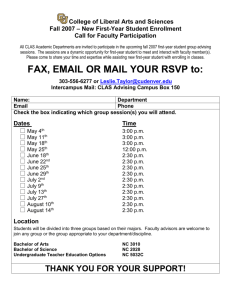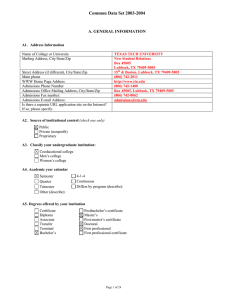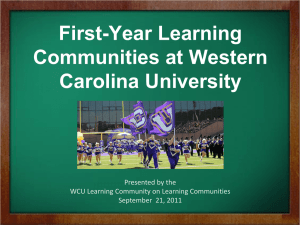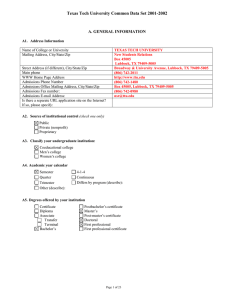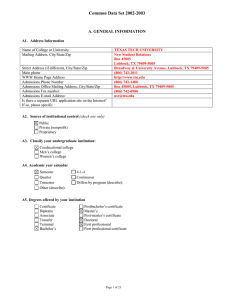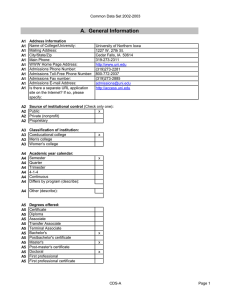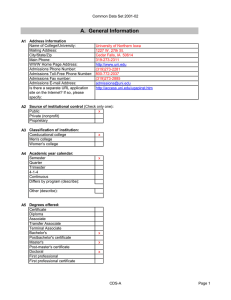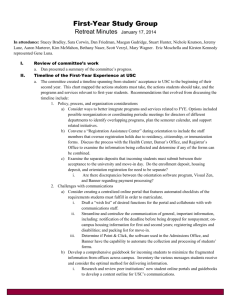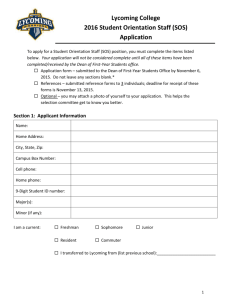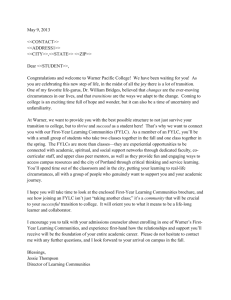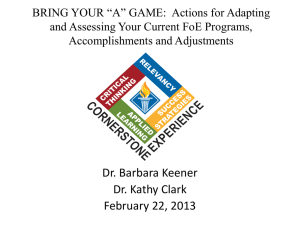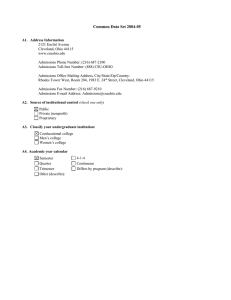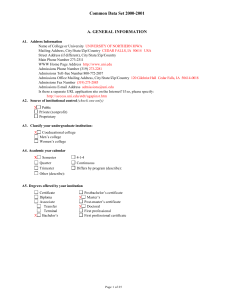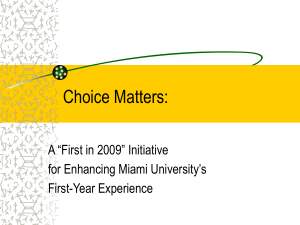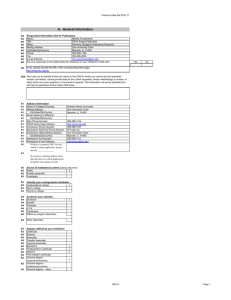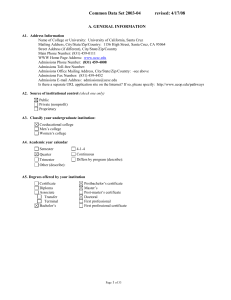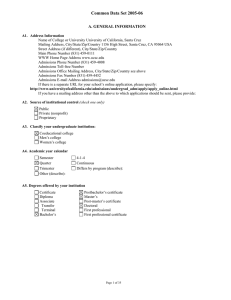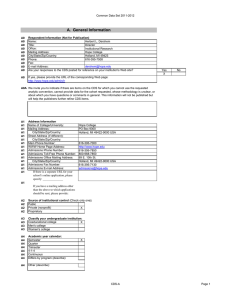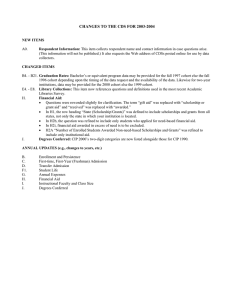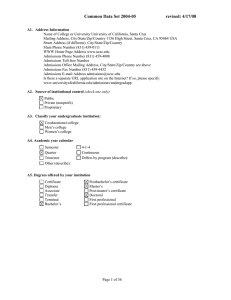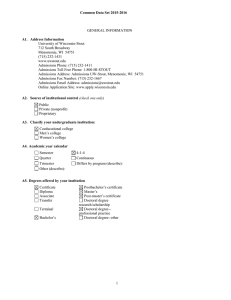2008 - University of Wisconsin
advertisement
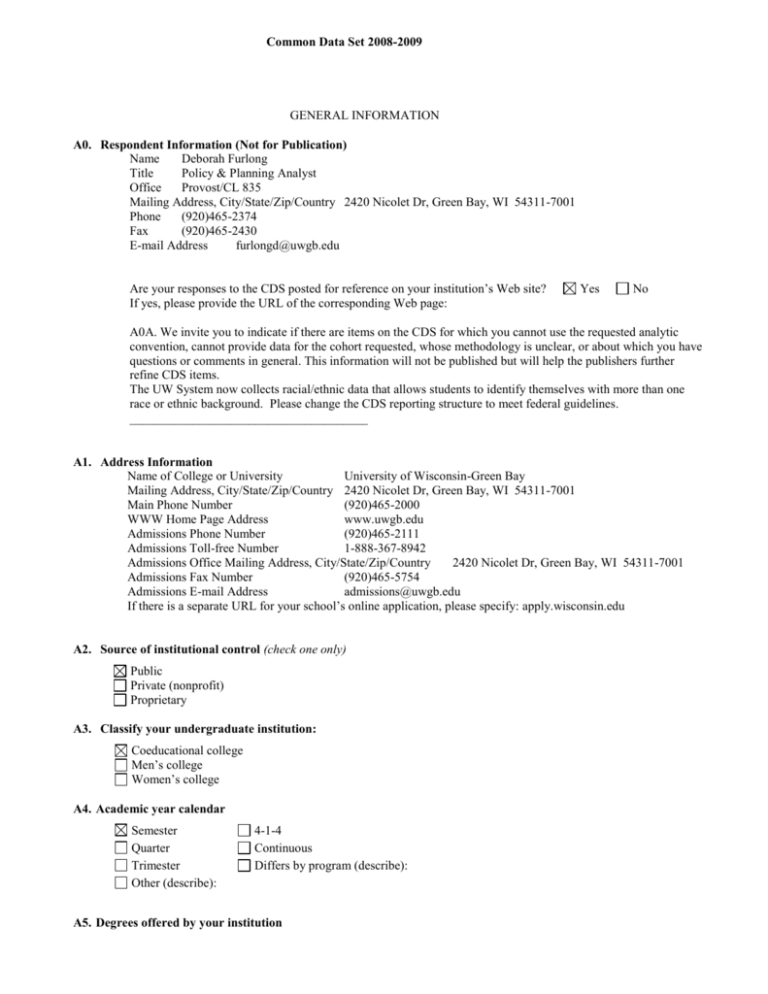
Common Data Set 2008-2009 GENERAL INFORMATION A0. Respondent Information (Not for Publication) Name Deborah Furlong Title Policy & Planning Analyst Office Provost/CL 835 Mailing Address, City/State/Zip/Country 2420 Nicolet Dr, Green Bay, WI 54311-7001 Phone (920)465-2374 Fax (920)465-2430 E-mail Address furlongd@uwgb.edu Are your responses to the CDS posted for reference on your institution’s Web site? If yes, please provide the URL of the corresponding Web page: Yes No A0A. We invite you to indicate if there are items on the CDS for which you cannot use the requested analytic convention, cannot provide data for the cohort requested, whose methodology is unclear, or about which you have questions or comments in general. This information will not be published but will help the publishers further refine CDS items. The UW System now collects racial/ethnic data that allows students to identify themselves with more than one race or ethnic background. Please change the CDS reporting structure to meet federal guidelines. ______________________________________ A1. Address Information Name of College or University University of Wisconsin-Green Bay Mailing Address, City/State/Zip/Country 2420 Nicolet Dr, Green Bay, WI 54311-7001 Main Phone Number (920)465-2000 WWW Home Page Address www.uwgb.edu Admissions Phone Number (920)465-2111 Admissions Toll-free Number 1-888-367-8942 Admissions Office Mailing Address, City/State/Zip/Country 2420 Nicolet Dr, Green Bay, WI 54311-7001 Admissions Fax Number (920)465-5754 Admissions E-mail Address admissions@uwgb.edu If there is a separate URL for your school’s online application, please specify: apply.wisconsin.edu A2. Source of institutional control (check one only) Public Private (nonprofit) Proprietary A3. Classify your undergraduate institution: Coeducational college Men’s college Women’s college A4. Academic year calendar Semester Quarter Trimester Other (describe): 4-1-4 Continuous Differs by program (describe): A5. Degrees offered by your institution Common Data Set 2008-2009 Certificate Diploma Associate Transfer Terminal Bachelor’s Postbachelor’s certificate Master’s Post-master’s certificate Doctoral First professional First professional certificate B. ENROLLMENT AND PERSISTENCE B1. Institutional Enrollment—Men and Women Provide numbers of students for each of the following categories as of the institution’s official fall reporting date or as of October 15, 2008. Men FULL-TIME Women Men PART-TIME Women Undergraduates Degree-seeking, first-time freshmen Other first-year, degreeseeking All other degree-seeking Total degree-seeking 386 614 5 12 77 96 14 23 1272 2261 269 697 1735 2971 288 732 4 6 129 194 1739 2977 417 926 Degree-seeking, first-time 4 13 9 23 All other degree-seeking 4 21 37 51 All other graduates enrolled in credit courses Total graduate 1 0 12 41 9 34 58 115 All other undergraduates enrolled in credit courses Total undergraduates Graduate Total all undergraduates: 6059 (matriculated = 5726; Special = 333) Total all graduate and professional students: 216 (matriculated = 162; special = 54) GRAND TOTAL ALL STUDENTS: 6275 Federal FTE = FT + 1/3 of PT = 4760 FT + 1/3* 1515 PT = 4760+505 = 5265 Common Data Set 2008-2009 B2. Enrollment by Racial/Ethnic Category. Provide numbers of undergraduate students for each of the following categories as of the institution’s official fall reporting date or as of October 15, 2008. Include international students only in the category "Nonresident aliens." Complete the “Total Undergraduates” column only if you cannot provide data for the first two columns. Degree-seeking First-time First year Nonresident aliens Black, non-Hispanic 3 14 Degree-seeking Undergraduates (include first-time first-year) 47 47 Total Undergraduates (both degree- and nondegree-seeking) 54 50 American Indian or Alaska Native Asian or Pacific Islander Hispanic White, non-Hispanic 18 27 20 928 123 173 117 5152 131 178 118 5459 Race/ethnicity unknown Total 7 1017 67 5726 69 6059 Persistence B3. Number of degrees awarded by your institution from July 1, 2007, to June 30, 2008. Associate degrees Bachelor’s degrees Postbachelor’s certificates Master’s degrees 3 984 34 48 Graduation Rates The items in this section correspond to data elements collected by the IPEDS Web-based Data Collection System’s Graduation Rate Survey (GRS). For complete instructions and definitions of data elements, see the IPEDS GRS instructions and glossary on the 2008 Web-based survey. For Bachelor’s or Equivalent Programs Fall 2002 Cohort B4. Initial 2002 cohort of first-time, full-time bachelor’s degree-seeking undergraduate students: 895 B6. Final 2002 cohort, after adjusting for allowable exclusions: 895 B7. Of the initial 2002 cohort, how many completed the program in four years or less 205 B8. Hhow many completed the program in more than four years but in five years or less: 252 B9. Hhow many completed the program in more than five years but in six years or less: 40 B10. Total graduating within six years (sum of questions B7, B8, and B9): 497 B11. Six-year graduation rate for 2002 cohort (question B10 divided by question B6): 56% Common Data Set 2008-2009 Retention Rates B22. For the cohort of all full-time bachelor’s (or equivalent) degree-seeking undergraduate students who entered your institution as freshmen in fall 2007 (or the preceding summer term), what percentage was enrolled at your institution as of the date your institution calculates its official enrollment in fall 2008? 73 % C. FIRST-TIME, FIRST-YEAR (FRESHMAN) ADMISSION Applications C1. First-time, first-year (freshman) students: Fall 2008 Total first-time, first-year (freshman) men who applied Total first-time, first-year (freshman) women who applied 1371 2298 Total first-time, first-year (freshman) men who were admitted Total first-time, first-year (freshman) women who were admitted 1706 926 Total full-time, first-time, first-year (freshman) men who enrolled Total part-time, first-time, first-year (freshman) men who enrolled Total appl = 3669 Total admit= 2632 Adm Rate= 72% Enroll = 1017 386 5 Total full-time, first-time, first-year (freshman) women who enrolled Total part-time, first-time, first-year (freshman) women who enrolled Yield = 39% 614 12 C2. Freshman wait-listed students Do you have a policy of placing students on a waiting list? If yes, please answer the questions below for fall 2008 admissions: Yes No Number of qualified applicants offered a place on waiting list 104 Number accepting a place on the waiting list 104 Number of wait-listed students admitted 104 Is your waiting list ranked? No Admission Requirements C3. High school completion requirement Check the appropriate box to identify your high school completion requirement for degree-seeking entering students: High school diploma is required and GED is accepted High school diploma is required and GED is not accepted High school diploma or equivalent is not required C4. Does your institution require or recommend a general college-preparatory program for degree-seeking students? Require Recommend Neither require nor recommend Common Data Set 2008-2009 C5. Distribution of high school units required and/or recommended. Specify the distribution of academic high school course units required and/or recommended of all or most degree-seeking students using Carnegie units (one unit equals one year of study or its equivalent). If you use a different system for calculating units, please convert. Units Required Units Recommended Total academic units 17 19 English Mathematics Science Of these, units that must be lab Foreign language Social studies History Academic electives 4 3 3 1 0 3 0 4 4 3 3 1 2 3 0 4 Basis for Selection C6. Open admission policy as described above for all students No C7. Relative importance of each of the following academic and nonacademic factors in your first-time, first-year, degree-seeking (freshman) admission decisions. Very Important Important Considered Not Considered Academic Rigor of secondary school record Class rank Academic GPA Standardized test scores Application Essay Recommendation Nonacademic Interview Extracurricular activities Talent/ability Character/personal qualities First generation Alumni/ae relation Geographical residence State residency Religious affiliation/commitment Racial/ethnic status Volunteer work Work experience Level of applicant’s interest SAT and ACT Policies C8. Entrance exams A. Does your institution make use of SAT, ACT, or SAT Subject Test scores in admission decisions for first-time, first-year, degree-seeking applicants? Yes No ADMISSION Common Data Set 2008-2009 Require Recommend Require for Some Consider If Submitted Not Used SAT or ACT ACT only SAT only SAT and SAT Subject Tests or ACT SAT Subject Tests B. If your institution will make use of the ACT in admission decisions for first-time, first-year, degree-seeking applicants for fall 2010, please indicate which ONE of the following applies (regardless of whether the writing score will be used in the admissions process): ___ ACT with Writing component required ___ ACT with Writing component recommended. X ACT with or without Writing component accepted C. Please indicate how your institution will use the SAT or ACT essay component; check all that apply. SAT essay ACT essay For admission For placement For advising D. In addition, does your institution use applicants' test scores for academic advising? _X__ yes ___ no E. Latest date by which SAT or ACT scores must be received for fall-term admission – until admissions close; date varies G. Please indicate which tests your institution uses for placement (e.g., state tests): SAT ACT SAT Subject Tests AP CLEP Institutional Exam State Exam (specify): Wisconsin Math Placement Test Freshman Profile _ Fall 2008 C9. Percent and number of first-time, first-year (freshman) students enrolled in fall 2008 who submitted national standardized (SAT/ACT) test scores. Percent submitting SAT scores Percent submitting ACT scores ACT Composite ACT Math ACT English ACT English Writing 1% Number submitting SAT scores 13 98% Number submitting ACT scores 1001 (54% submitted writing sub scores for the ACT, n=553) 25th Percentile 20 19 19 19 ACT 75th Percentile 25 25 25 24 ACT English ACT Math Common Data Set 2008-2009 30-36 24-29 18-23 12-17 6-11 Below 6 Composite 2% 35% 59% 4% 100% 4% 30% 53% 13% 100% 3% 38% 47% 12% 100% C10. Percent of all degree-seeking, first-time, first-year (freshman) students who had high school class rank within each of the following ranges (report information for those students from whom you collected high school rank information). UW-Green Bay does not use high school rank in the admission process. When students submit their high school rank, the information may be used in the decision. It is not routinely stored in the University data base. C11. Percentage of all enrolled, degree-seeking, first-time, first-year (freshman) students who had high school gradepoint averages within each of the following ranges (using 4.0 scale). Report information only for those students from whom you collected high school GPA. Percent who had GPA of 3.75 and higher Percent who had GPA between 3.50 and 3.74 Percent who had GPA between 3.25 and 3.49 Percent who had GPA between 3.00 and 3.24 17% 15% 22% 21% Percent who had GPA between 2.50 and 2.99 Percent who had GPA between 2.0 and 2.49 22% 3% Percent who had GPA between 1.0 and 1.99 Percent who had GPA below 1.0 100% C12. Average high school GPA of all degree-seeking, first-time, first-year (freshman): 3.27 Percent of total first-time, first-year (freshman) students who submitted high school GPA: 99% Admission Policies C13. Application fee Does your institution have an application fee? Yes No Amount of application fee: $44 Can it be waived for applicants with financial need? Yes No If you have an application fee and an on-line application option, please indicate policy for students who apply on-line: Same fee: X Can on-line application fee be waived for applicants with financial need? Yes C14. Application closing date Does your institution have an application closing date? Application closing date (fall): __________ Priority date: April 15 Yes C15. Are first-time, first-year students accepted for terms other than the fall? C16. Notification to applicants of admission decision sent (fill in one only) On a rolling basis beginning (date): September 15 No Yes No Common Data Set 2008-2009 C17. Reply policy for admitted applicants (fill in one only) Must reply by (date): __________ No set date: X Must reply by May 1 or within _____ weeks if notified thereafter Other: __________ Deadline for housing deposit (MMDD): no deadline Amount of housing deposit: $225 Refundable if student does not enroll? X Yes, in full, until May 1st; then refunds are handled on a case-by-case basis ___ Yes, in part ____ No C18. Deferred admission: Does your institution allow students to postpone enrollment after admission? Yes No If yes, maximum period of postponement: 1 year C19. Early admission of high school students: Does your institution allow high school students to enroll as full-time, firsttime, first-year (freshman) students one year or more before high school graduation? Yes No Early Decision and Early Action Plans UW-Green Bay has neither early decision nor early action plans. D. TRANSFER ADMISSION Fall Applicants D1. Does your institution enroll transfer students? Yes No If yes, may transfer students earn advanced standing credit by transferring credits earned from course work completed at other colleges/universities? Yes No D2. Provide the number of students who applied, were admitted, and enrolled as degree-seeking transfer students in fall 2008. Men Women Total Applicants 520 953 1473 Admitted Applicants 360 717 1077 Enrolled Applicants 244 474 718 Application for Admission D3. Indicate terms for which transfers may enroll: Fall Winter Spring Summer D4. Must a transfer applicant have a minimum number of credits completed or else must apply as an entering freshman? Yes No Minimum number of credits and the unit of measure? 15 college credits completed after high school graduation D5. Indicate all items required of transfer students to apply for admission: Required Recommended Recommended of All of All of Some High school transcript Required of Some Not required X Common Data Set 2008-2009 College transcript(s) Essay or personal statement Interview Standardized test scores Statement of good standing from prior institution(s) X X X X X D6. If a minimum high school grade point average is required of transfer applicants, specify (on a 4.0 scale): None D7. If a minimum college grade point average is required of transfer applicants, specify (on a 4.0 scale): 2.0 although students below 2.5 are routinely waitlisted D8. List any other application requirements specific to transfer applicants: None D9. List application priority, closing, notification, and candidate reply dates for transfer students. If applications are reviewed on a continuous or rolling basis, place a check mark in the “Rolling admission” column. Priority Date Closing Date Notification Date Reply Date Rolling Admission Fall Feb. 1 X Spring Nov. 1 X Summer X D10. Does an open admission policy, if reported, apply to transfer students? Yes No D11. Describe additional requirements for transfer admission, if applicable: None D12. Report the lowest grade earned for any course that may be transferred for credit: D D13. Maximum number of credits or courses that may be transferred from a two-year institution: 72 Credits D14. Maximum number of credits or courses that may be transferred from a four-year institution: No maximum D15. Minimum number of credits that transfers must complete at your institution to earn an associate degree: 15 credits D16. Minimum number of credits that transfers must complete at your institution to earn a bachelor’s degree: 31 credits D17. Describe other transfer credit policies: At least half of all upper division requirements for the major and minor must be completed in residence at UW-Green Bay. E. ACADEMIC OFFERINGS AND POLICIES E1. Special study options: Identify those programs available at your institution. Refer to the glossary for definitions. Accelerated program Cooperative education program Cross-registration Distance learning Double major Dual enrollment English as a Second Language (ESL) Exchange student program (domestic) External degree program Other (specify): Honors program Independent study Internships Liberal arts/career combination Student-designed major Study abroad Teacher certification program Weekend college E3. Areas in which all or most students are required to complete some course work prior to graduation: Arts/fine arts Computer literacy English (including composition) Foreign languages History Other (describe): Humanities Mathematics Philosophy Sciences (biological or physical) Social science F. STUDENT LIFE F1. Percentages of first-time, first-year (freshman) degree-seeking students and degree-seeking undergraduates enrolled in Fall 2008 who fit the following categories: First-time, first-year Undergraduates (freshman) students Common Data Set 2008-2009 Percent who are from out of state (exclude international/nonresident aliens from the numerator and denominator) Percent of men who join fraternities Percent of women who join sororities Percent who live in college-owned, -operated, or -affiliated housing Percent who live off campus or commute Percent of students age 25 and older Average age of full-time students Average age of all students (full- and part-time) 5% 1% 1% 80% 20% 1% 18 18 5% 1% 1% 33% 67% 20% 21 23 F2. Activities offered Identify those programs available at your institution. Campus Ministries Choral groups Concert band Dance Drama/theater International Student Organization Jazz band Literary magazine Marching band Model UN Music ensembles Musical theater Opera Radio station Student government Student newspaper Student-run film society Symphony orchestra Television station Pep band Yearbook F3. ROTC (program offered in cooperation with Reserve Officers’ Training Corps) Army ROTC is offered: On campus At cooperating institution (name): St. Norbert College (De Pere) F4. Housing: Check all types of college-owned, -operated, or -affiliated housing available for undergraduates at your institution. Coed dorms Men’s dorms Women’s dorms Apartments for married students Apartments for single students Special housing for disabled students Special housing for international students Fraternity/sorority housing Cooperative housing Theme housing Wellness housing Other housing options (specify): ___________________________________________________ Common Data Set 2008-2009 G. ANNUAL EXPENSES Provide 2009-2010 academic year costs of attendance for the following categories that are applicable to your institution. Check here if your institution's 2009-2010 academic year costs of attendance are not available at this time and provide an approximate date (i.e., month/day) when your institution's final 2009-2010 academic year costs of attendance will be available: July 15, 2009 (After the July 9, 2009 meeting of the UW System Board of Regents) G1. Undergraduate full-time tuition, required fees, room and board FIRST-YEAR UNDERGRADUATES $5,084 $5,084 $12,657 $12,657 $12,657 $12,657 $1,224 $1,224 $3,250 - $3,500 $3,250 - $4,350 $1,400 - $2,300 $1,400 - $2,300 PUBLIC INSTITUTION Tuition: In-state (out-of-district): Out-of-state: NONRESIDENT ALIEN: Tuition: REQUIRED FEES: ROOM ONLY: (on-campus) 2009-10 BOARD ONLY: (on-campus meal plan) 2008-09 information Other: UW-Green Bay’s dining service uses a declining balance (debit card) process. Students who live in campus dormitories (which lack kitchens) must deposit at least $1,400 a year onto their dining card. G2. Number of credits per term a student can take for the stated full-time tuition G3. Do tuition and fees vary by year of study (e.g., sophomore, junior, senior)? 12 minimum Yes 18 maximum No G4. If tuition and fees vary by undergraduate instructional program, describe briefly: no variance G5. Provide the estimated expenses for a typical full-time undergraduate student: (financial aid budgets) Residents Books and supplies: Room only: Board only: Room and board total Transportation: Other expenses: Commuters (living at home) $800 $1,008 $1,360 $2,368 $660 $810 $800 $3,420 $2,040 $5,460 $660 $1,960 G6. Undergraduate per-credit-hour charges (tuition only): PUBLIC INSTITUTIONS In-state: Out-of-state: NONRESIDENT ALIENS: $212 $527 $527 Commuters (not living at home) $800 $3,420 $1,360 $4,780 $660 $1,960 Common Data Set 2008-2009 H. FINANCIAL AID Aid Awarded to Enrolled Undergraduates H1. Indicate the academic year for which data are reported for items H1, H2, H2A, and H6 below: 2008-2009 estimated Which needs-analysis methodology does your institution use in awarding institutional aid? Federal methodology (FM) Scholarships/Grants Federal State Institutional Scholarships/grants from external sources Total Scholarships/Grants Self-Help Student loans from all sources Federal Work-Study State and other work-study/employment Total Self-Help Parent Loans Tuition Waivers Athletic Awards Need-based (Include non-need-based aid use to meet need.) $ Non-need-based (Exclude non-need-based aid use to meet need.) $ $4,777,279 $3,161,725 $104,720 $922,131 $8,965,855 $70,422 $143,915 $542,959 $757,296 $10,357,629 $479,767 $11,120,409 $10,837,396 $11,120,409 $1,017,305 $427,259 $649,642 $490,116 $1,226,869 H2. Number of Enrolled Students Awarded Aid: a) b) c) d) e) f) g) h) i) j) k) l) m) Number of degree-seeking undergraduate students (CDS Item B1 if reporting on Fall 2008 cohort) Number of students in line a who applied for need-based financial aid Number of students in line b who were determined to have financial need Number of students in line c who were awarded any financial aid Number of students in line d who were awarded any need-based scholarship or grant aid Number of students in line d who were awarded any need-based self-help aid Number of students in line d who were awarded any non-need-based scholarship or grant aid Number of students in line d whose need was fully met On average, the percentage of need that was met of students who were awarded any need-based aid. The average financial aid package of those in line d. Average need-based scholarship or grant award of those in line e Average need-based self-help award of those in line f Average need-based loan of those in line f who were awarded a needbased loan First-time Full-time Freshmen 1000 Full-time Undergrad (Incl. Fresh) 4706 Less Than Full-time Undergrad 1020 869 586 563 343 3729 2777 2669 1472 517 420 359 227 434 2050 281 227 1169 137 281 1513 190 86% $9,075 $5,278 $4,017 $3,876 88% $9,610 $5,640 $4,575 $4,447 82% $9,220 $4,514 $5,077 $5,032 H2A. Number of Enrolled Students Awarded Non-need-based Scholarships and Grants: Common Data Set 2008-2009 n) Number of students in line a who had no financial need and who were awarded institutional non-need-based scholarship or grant aid o) Average dollar amount of institutional non-need-based scholarship and grant aid awarded to students in line n p) Number of students in line a who were awarded an institutional nonneed-based athletic scholarship or grant q) Average dollar amount of institutional non-need-based athletic scholarships and grants awarded to students in line p Note: These are the graduates and loan types to include and exclude in order to fill out CDS H4, H4a, H5 and H5a. Include: * * * First-time Full-time Freshmen 23 Full-time Undergrad (Incl. Fresh) 59 Less Than Full-time Undergrad 6 $1,294 20 $3,806 87 $2,448 0 $5,615 $7,467 Not Appl Class = 581; 164 had no loans 2008 undergraduate class who graduated between July 1, 2007 and June 30, 2008 who started at your institution as firsttime students and received a bachelor's degree between July 1, 2007 and June 30, 2008. only loans made to students who borrowed while enrolled at your institution. co-signed loans. Exclude: * those who transferred in. * money borrowed at other institutions. H4. Percentage of the class who borrowed at any time through any loan programs. 72% H4a. Percentage of the class who borrowed at any time through federal loan programs. 71% H5. Average per-borrower cumulative undergraduate indebtedness of those in line H4 . $18,587 H5a. Average per-borrower cumulative undergraduate indebtedness through federal loan programs. $17,083 Aid to Undergraduate Degree-seeking Nonresident Aliens (Fall 2008) H6. Indicate your institution’s policy regarding institutional scholarship and grant aid for undergraduate degree-seeking nonresident aliens: Institutional need-based scholarship or grant aid is available Institutional non-need-based scholarship or grant aid is available Institutional scholarship and grant aid is not available If institutional financial aid is available for undergraduate degree-seeking nonresident aliens, provide the number of undergraduate degree-seeking nonresident aliens who were awarded need-based or non-need-based aid: 15 Average dollar amount of institutional financial aid awarded to undergraduate degree-seeking nonresident aliens: $3,509 averaged across all international students; $11,931 average for those who received aid Total dollar amount of institutional financial aid awarded to undergraduate degree-seeking nonresident aliens: $178,959 H7. Check off all financial aid forms nonresident alien first-year financial aid applicants must submit: Common Data Set 2008-2009 Institution’s own financial aid form CSS/Financial Aid PROFILE International Student’s Financial Aid Application International Student’s Certification of Finances Other: _______________________________________________________________ Process for First-Year/Freshman Students H8. Check off all financial aid forms domestic first-year (freshman) financial aid applicants must submit: FAFSA Institution’s own financial aid form CSS/Financial Aid PROFILE State aid form Noncustodial PROFILE Business/Farm Supplement H9. Indicate filing dates for first-year (freshman) students: Priority date for filing required financial aid forms: April 1 No deadline for filing required forms (applications processed on a rolling basis): X H10. Indicate notification dates for first-year (freshman) students (answer a or b): Students notified on a rolling basis: yes/no If yes, starting date: Starting January 1 H11. Indicate reply dates: Students must reply within three weeks of notification. Types of Aid Available H12. Loans FEDERAL DIRECT STUDENT LOAN PROGRAM (DIRECT LOAN) NONE FEDERAL FAMILY EDUCATION LOAN PROGRAM (FFEL) FFEL Subsidized Stafford Loans FFEL Unsubsidized Stafford Loans FFEL PLUS Loans Federal Perkins Loans Federal Nursing Loans State Loans College/university loans from institutional funds H13. Scholarships and Grants NEED-BASED: Federal Pell SEOG State scholarships/grants Private scholarships College/university scholarship or grant aid from institutional funds United Negro College Fund Federal Nursing Scholarship H14. Check off criteria used in awarding institutional aid. Check all that apply. Non-need X Need-based Academics Non-need X Need-based Leadership Common Data Set 2008-2009 X X Alumni affiliation Art Athletics Job skills ROTC Minority status Music/drama Religious affiliation State/district residency X X --------------- H15. If your institution has recently implemented any major financial aid policy, program, or initiative to make your institution more affordable to incoming students such as replacing loans with grants, or waiving costs for families below a certain income level please provide details below: The most recent cost initiative involves a state-wide initiative to waive tuition for all Wisconsin military veterans. I. INSTRUCTIONAL FACULTY AND CLASS SIZE – Fall 2008 I-1. Please report the number of instructional faculty members in each category for fall 2008. Include faculty who are on your institution’s payroll on the census date your institution uses for IPEDS/AAUP. a.) Total number of instructional faculty b.) Total number who are members of minority groups c.) Total number who are women d.) Total number who are men e.) Total number who are nonresident aliens (international) f.) Total number with doctorate, first professional, or other terminal degree g.) Total number whose highest degree is a master’s but not a terminal master’s h.) Total number whose highest degree is a bachelor’s i.) Total number whose highest degree is unknown or other (Note: Items f, g, h, and i must sum up to item a.) j.) Total number in stand-alone graduate/professional programs in which faculty teach virtually only graduate-level students Full-time 188 26 Part-time 146 6 Total 334 32 78 110 Unknown 82 64 Unknown 160 174 Unknown 162 24 186 24 43 67 2 24 26 0 55 55 0 0 0 I-2. Student to Faculty Ratio Fall 2008 Student to Faculty ratio: 22 to 1 (based on 5365 students and 237 faculty). Federal FTE students = FT + 1/3 of PT = 4760 FT + 1/3* 1515 PT = 4760+505 = 5265 Federal FTE faculty = 188 + 1/3 *146 = 237 Common Data Set 2008-2009 I-3. Undergraduate Class Size Number of Class Sections with Undergraduates Enrolled CLASS SECTIONS CLASS SUBSECTIONS 2-9 60 2-9 16 Undergraduate Class Size (provide numbers) 10-19 20-29 30-39 40-49 121 168 116 77 10-19 24 20-29 54 30-39 8 40-49 6 50-99 71 100+ 28 Total 641 50-99 0 100+ 0 Total 108 J. Disciplinary areas of DEGREES CONFERRED Degrees conferred between July 1, 2007 and June 30, 2008 Category Natural resources/environmental science Area and ethnic studies Communications/journalism Computer and information sciences Education Foreign languages and literature English Liberal arts/general studies Biological/life sciences Mathematics Interdisciplinary studies Philosophy and religious studies Physical sciences Psychology Public administration and social services Social sciences Visual and performing arts Health professions and related sciences Business/marketing History TOTAL Associate 100% 100% Bachelor’s 1% 1% 6% 2% 6% 1% 2% 2% 10% 2% 3% 1% 1% 18% 6% 7% 7% 4% 17% 3% 100% CIP 2000 Categories to Include 3 5 9 11 13 16 23 24 26 27 30 38 40 42 44 45 50 51 52 54 Note: Art and Visual Design is listed under Visual and Performing Arts; interdisciplinary majors in the three Community Science units are listed under Social Sciences except Public Administation, which is listed in CIP 42; Human Biology is listed under Biological/life Sciences; Human Development is listed under Psychology; Humanistic Studies is listed under Liberal arts/general studies. Only the Interdisciplinary Studies major and Individual major are listed under the Interdsciplinary Studies category.
